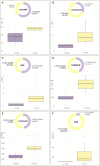Erythrocyte sedimentation rate in canine leishmaniosis diagnosis: A new resource
- PMID: 35978706
- PMCID: PMC9376380
- DOI: 10.3389/fvets.2022.949372
Erythrocyte sedimentation rate in canine leishmaniosis diagnosis: A new resource
Abstract
This study aims to evaluate the erythrocyte sedimentation rate (ESR) in Leishmania infantum-seropositive dogs compared with healthy dogs and to assess the existence of a correlation between ESR and clinical form of Canine leishmaniosis (CanL) as well as acute phase proteins (APPs). From October 2021 to January 2022, dogs were recruited in this study if L. infantum-seropositive by enzyme-linked immunoassay and classified as exposed or affected by a CanL active form based on physical examination, clinical score, and laboratory results [i.e., complete blood count, biochemical panel such as C-reactive protein (CRP) and serum ferritin, serum protein electrophoresis, and fibrinogen concentration measurement]. To evaluate the ESR of the dogs, a point-of-care device was used with a reference interval of 0-10 mm/h. Moreover, the ESR evaluation has been also performed in clinically healthy dogs, as control group. Thirty-six L. infantum-seropositive dogs [i.e., exposed (n = 10) and affected by CanL active form (n = 26)] were included in the study. Twenty-two healthy dogs were also enrolled. The mean value of ESR in dogs affected by a CanL active form was significantly higher than in exposed and healthy dogs (p < 0.0001). The ESR level was increased in 92% of dogs with CanL active form while positive APPs such as CRP, fibrinogen, and serum ferritin were increased only in 46, 48, and 58% of the animals, respectively. In exposed dogs, the ESR level was increased in 40% of cases. In dogs with active form, a significant positive correlation between ESR and total proteins, globulins, CRP, and fibrinogen, as well as a significant negative correlation between ESR and hematocrit, hemoglobin, and albumin/globulin ratio were detected. This study provides for the first-time data on ESR in L. infantum-seropositive dogs demonstrating dogs affected by a CanL active form have the highest ESR level and the majority of these dogs presented an increased ESR compared with exposed and healthy dogs. The evaluation of ESR by a point-of-care device proved to be a simple, inexpensive, and ready-to-use benchtop tool and ESR can be considered a helpful and timely inflammatory biomarker for the diagnosis of a CanL active form.
Keywords: CRP; ESR; Leishmania infantum; active form; acute-phase proteins; dog; exposed; serum ferritin.
Copyright © 2022 Cavalera, Gernone, Uva, Donghia, Carelli, Iatta and Zatelli.
Conflict of interest statement
The authors declare that the research was conducted in the absence of any commercial or financial relationships that could be construed as a potential conflict of interest.
Figures
References
-
- Paltrinieri S, Solano-Gallego L, Fondati A, Lubas G, Gradoni L, Castagnaro M, et al. . Canine Leishmaniasis Working Group, Italian Society of Veterinarians of Companion Animals. Guidelines for diagnosis and clinical classification of leishmaniasis in dogs. J Am Vet Med Assoc. (2010) 236:1184–91. 10.2460/javma.236.11.1184 - DOI - PubMed
LinkOut - more resources
Full Text Sources
Research Materials
Miscellaneous


